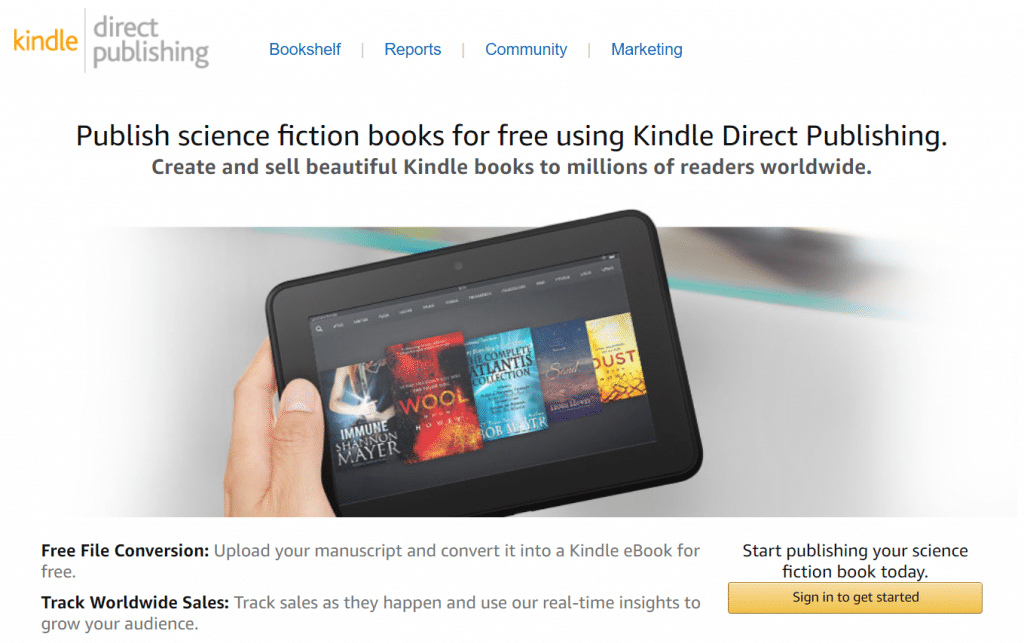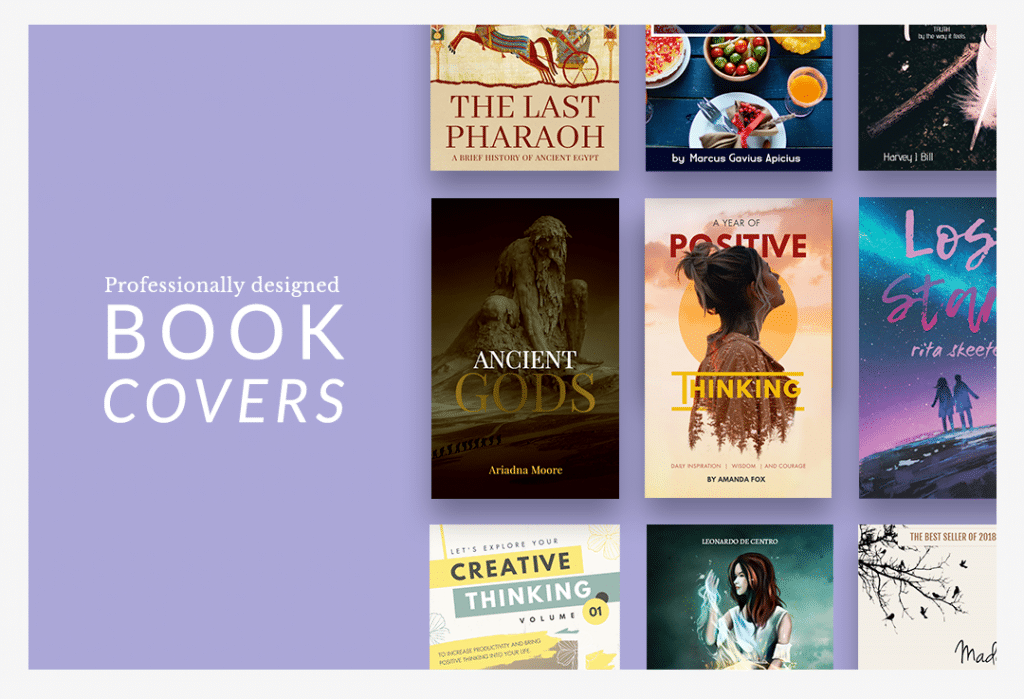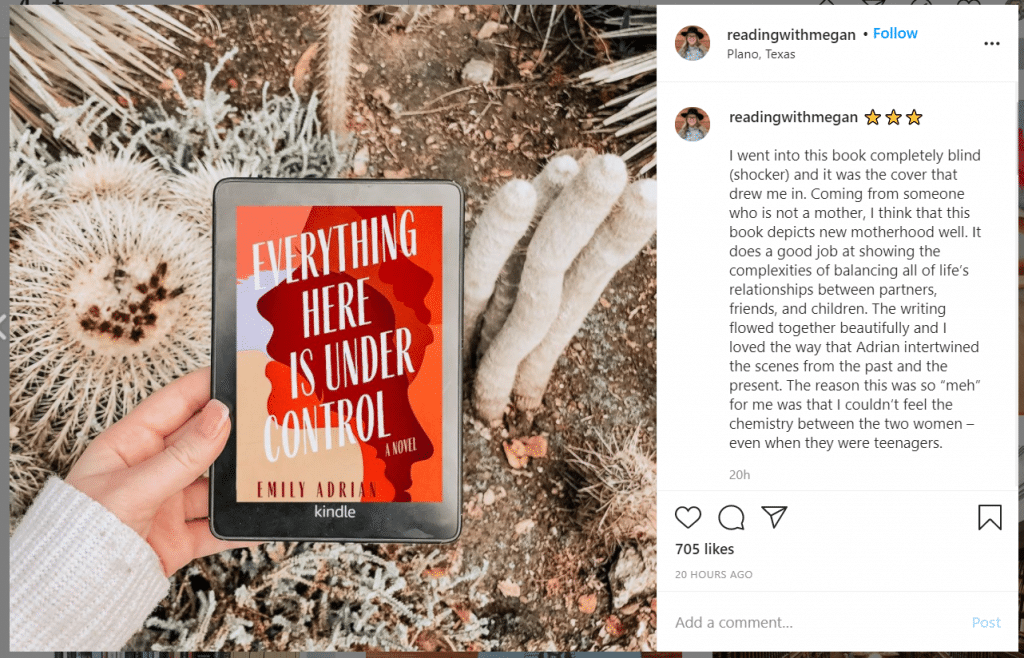
You’ve conceptualized the perfect idea and completed the titanic feat of writing a book. Congrats! Now all that’s left to do is publish! If only it were that easy. The truth is that writing the book is the easy part. Now you must undertake the tremendous journey toward self-publishing a book without breaking the bank.
If you’ve arrived here, you’ve likely felt indecisive between the options of traditional versus self-publishing. There are pros and cons to each, but self-publishing offers more creative freedom, complete ownership over content, and a 100% share of royalties.
There is a caveat: you’ll have to take a DIY approach that suits your budget and publishing goals.
Navigating the self-publishing waters is overwhelming for new authors. As you’ll quickly learn, the entire process boils down to a solid strategy and logistics.
Fortunately, you don’t have to compromise quality or integrity because you’ll learn every step of self-publishing in this comprehensive guide — from editing to pre- and post-launch marketing.
Ready to land on the bestseller’s list? Let’s publish your book!
“A professional writer is an amateur who didn’t quit” —Richard Bach
Preparing Your Book For Publishing
As you round the last turn on the journey of writing your book, the prospect of publishing is in your peripheral. For decades the industry-standard centered around traditional publishing, which goes something like this:
A writer authors a book and pitches it to literary agents who help get the book published. With sizable funding backing the book’s success, few writers breach the stacks of rejection letters to become published authors.
That was the status-quo until 2009 when Amazon Publishing was born.

Suddenly, aspiring novelists saw a covert entry point to circumvent the staunch publishing gatekeepers, one that offered complete creative control and a guarantee that their books would be published.
Despite this new opportunity for exposure, self-publishing isn’t for everyone. You’ll have to work hard and invest valuable sweat-equity. Authors who persist past the inevitable obstacles of self-publishing can achieve notoriety and global success.
Just look at author E.L. James, whose originally self-published novel, Fifty Shades of Grey, sold 15.2 million copies from 2010-19.
While it worked for James, self-publishing isn’t for everyone. Your first task is to figure out if it’s right for you by looking at the advantages.
Is self-publishing Right For You?
- Guaranteed publishing: There are thousands of would-be novelists out there. Everyone knows someone who is currently writing a book or telling every writer that their life story should be a book. With self-publishing, you guarantee that, no matter what, your book gets published. That alone is incentive enough to sweeten the prospect of self-publishing.
- Complete creative freedom: If you land a book deal with a publishing house, details like the cover design, word-count, and even the title, are subject to change. However, when you go the self-publishing route, every decision is entirely at your discretion to uphold your book’s integrity. You control all editorial decisions and don’t have to compromise on creative direction.
- 100% ownership of content. When you self-publish your book, you don’t just get a few slices of the pie; you get the whole thing. You won’t have to split copyright or ownership of the content and rights because they belong entirely to you. Conversely, traditional publishing involves more parties, and thus, less control on your end.
- Keep all the royalties: Many authors have had success self-publishing, and guess what? They get to keep 100% of the profit and royalties. There is no literary agent to pay a 10% fee, and no publishing house to collect their portion. If you sell your book exclusively online, you’ll also cut out retailer’s costs. Bottom line: you do 100% of the work and keep 100% of the profits.
Are you leaning toward self-publishing? Let’s get to the nuts and bolts of how to do it on a budget. You’ll incur plenty of opportunities to squander exorbitant funds on editors and graphic designers, but these steps will help you avoid falling into any money traps.
You can self-publish your book on a budget, but you’ll need a smart strategy in place. Let’s tackle the logistics.
Polish Your Manuscript To Perfection
“The first draft is black and white. Editing gives the story color.” — Emma Hill
I want you to succeed, so I’ll be frank: just because you’re self-publishing doesn’t mean you’ll cut corners. In fact, you’ll need to tread cautiously to ensure you’re devoting the care and meticulous detail your book deserves. Otherwise, the final product will be substandard. And nothing says rookie like grammatical errors and plot holes.
To avoid these mistakes, you’ll need to hire a meticulous editor with a hawk-eye for detail.
However, before you send your precious manuscript off to a professional editor, you’ll need it in the best condition possible. After all, you don’t want to waste money paying an editor to correct minor grammar mistakes you could’ve caught self-editing.
Tips For Self-Editing Your Book
Do you have a relative or family friend who’s an English professor? Ask them if they wouldn’t mind editing your book. Alternatively, join a writers group on Facebook and swap edits with another aspiring author.
A foolproof resource for finding beta-readers is to tweet a brief synopsis of your book on Twitter and ask for beta readers with the hashtags, #writingcommunity, and #betareaders. Don’t be surprised if hordes of passionate scribes jump to aid, as the Twitter writing community is notoriously supportive!
I’ve personally made excellent connections and recruited beta readers for my fiction novel with this tactic.
Before you hire a professional editor, you should:
- Self-edit your book in its entirety for grammar, structure, and flow
- Recruit beta-readers to provide honest feedback on the plot and look out for any inconsistencies
- Edit your book again based on the feedback from your beta readers
Ok, so now that you’ve turned over every stone of self-editing, let’s help you find a professional editor to bring in the heavy artillery.
How To Hire A Book Editor
- Decide what type of edit you need. Does your book need a simple edit for grammar and flow? Or do you need an in-depth developmental edit to help with plot points and story direction? Decide if you need an editor, copy editor, or proofreader. For a little more insight into these categories, check out this post.
- Is your book fiction or nonfiction? You wouldn’t want to hire a personal memoir editor to tackle your teen fantasy fiction or vice versa. The type of book you’re writing will shape the ideal editor for the job.
- Search online marketplaces. There are thousands of editors online, and finding the right one is crucial. Marketplaces like Reedsy and Upwork let you filter your search to find vetted freelancers with reviews and published work experience in your genre. If you prefer a personal referral, tweet a request for editor recommendations.
As you sprinkle the final gold dust throughout your book, you’ll have a laser-sharp vision of what emotions and feelings it should evoke. How will you translate the theme of your book to prospective readers?
An attention-grabbing book cover design will do the trick!
Choosing Your Book’s Cover Design
Don’t judge me as I dole out a cliché, but it must be said: without hesitation, people WILL judge your book by its cover, so it better be good.
I can’t tell you how many writers I’ve seen pour every fiber of their existence into writing the best book possible, only to cheat themselves with a poor cover design.
It’s heartbreaking. The cover design is one area you want to approach strategically. No, you don’t need to hire an extravagant graphic designer to portray your book best. However, you will need to think long and hard about how you want people to perceive your book.

How To Design Your Book Cover
- Research popular cover designs in your genre. Head over to Amazon Books, Goodreads, and Barnes & Noble and browse books in your genre. Be as precise as possible. If you’re writing historical fiction, zoom in to the specifics and search for “historical romance fiction” or “British historical 17th-century fiction.” The more specific, the more accurate a depiction you’ll get of the current genre-specific cover design trends.
- Create an inspiration folder of your favorite covers. Compile all of these covers into a folder on Pinterest or bookmark them in your web browser. Go through each one and jot down notes of what you like and don’t like. Again, be as detailed as possible to start building the framework for what you want, and don’t want, for your cover.
- Design your book cover. Hiring a graphic designer for your book cover is expensive. You can save costs without compromising design by using free design software online. Use PosterMyWall book cover templates to design a great-looking cover on a budget. As you work from the easy-to-use editor, keep your inspirational covers nearby to draw influence on fonts, colors, or design elements you like.

Look at you; you’re a regular Hemingway in the works! Your book is polished, designed, and ready to self-publish! But where will you publish it?
How And Where To Self-Publish Your Book
You’ll want to make your book formatting available in two formats: eBook and print on demand. Gone are the days of forking out thousands for bulk print copies. With Amazon’s Kindle Direct Publishing (KDP), you simply upload your book, list it, and only print paperback copies for each order.
Anyone can purchase and download an eBook and read it from their device. For both formats, you’ll need an ISBN, and the industry-standard is Bowker. Considering a single ISBN and Barcode cost $125 each, it’s more cost-effective to purchase 10 ISBNs for $295.
You likely don’t need 10 ISBNs right now, but you’ll undoubtedly have more work in the future, and they don’t expire.
eBooks
Many authors choose KDP for their eBooks because of the high royalties and affordable price points. However, you can also research alternatives like Smashwords, IngramSpark, and Lulu.
Best part? Your book will read the same in terms of layout and format quality as famous novels like Moby Dick.
Print On Demand
Similar to eBook, you’ll upload your manuscript to a POD service like KDP or IngramSpark. Instead of purchasing copies in bulk, the service prints on-demand precisely the amount ordered. Technically, POD is more expensive per copy. However, in the long run, you’ll offset costs because you won’t print excess copies that become dust-collectors.
Before you set a publishing date, consider this:
The task-list leading up to publishing is large, and marketing is one area you don’t want to skimp on unless you’d only like your immediate family to read your book. As much as granny brags about your writing to her bingo club, I’m betting you want a broader readership.
Many publishers and experts recommend you give yourself six months to a year for pre-launch marketing. Why? Because there’s a lot to do. How do you eat an elephant? Let’s dive in, one bite at a time.
“Almost anyone can be an author; the business is to collect money and fame from this state of being.” —A. A. Milne
A Complete Pre-Launch Marketing Strategy
Most of us writers are perfectly content sitting at a desk tapping away at the keyboard and bringing worlds to life. But marketing? That’s where things get tricky.
Marketing a book feels like being figuratively drawn and quartered. There are tasks in every direction tugging at your attention. So, which ones do you focus on? Bridging the gap between creativity and business strategy isn’t easy, but it’s possible and necessary if you want your book to turn into a lucrative business.
To keep the process concise and effective, follow these steps.
Build A Following On Twitter
Want to get screen to screen with your target readers? Then it’s time to get serious about Twitter. At this point, you might be wondering if Twitter sponsored this post. The answer is no, and that’s proof of how supportive the Twitter writing community is.
Writing circles thrive in this sacred digital space. I built my Twitter following from zero to over 800 by writing personalized micro poems based on people’s bios for anyone who commented with their favorite color.
Soon after, followers started tagging me in their tweets about writer accounts to follow. If you want to build your writing network, spitball ideas, network with editors, and find beta readers — Twitter is free and too fruitful to overlook.
Create A Keyword Strategy
When you drive somewhere, you want to take the shortest, quickest route toward your destination, right? The same goes for self-publishing, except, instead of directions, you’ll need keywords.
The key to a successful book launch is to make your book discoverable and attract the right readers. Keywords position your book to appear when customers search specific terms within your genre. Nail this tactic, and you’ll boost your book’s presence in search results and get your book in front of more eyeballs.
The process is straightforward if you follow these steps:
- Go to Amazon Books or Kindle Store
- Choose a category that best aligns with your book’s genre, for example, let’s browse “Literature & Fiction”.
- On the left side of the screen, notice the subcategories under this genre, like “Genre Fiction” and “Mythology & Folk Tales.” Find the subcategories that are most specific to your genre. We’ll zoom in on “Genre Fiction,” which is still pretty vague, so we need to isolate particular keywords.
- In the same left panel, you’ll see specific themes like “Coming of Age,” “Psychological,” and “Sea Stories.”
- Now go back to Amazon Books and restart your search. Enter the relative terms into the search bar, and as you type, a drop-down menu intuitively predicts what you’re going to type. If I start typing “coming of age,” I can see there are several search terms I can use, including “Coming of age fiction,” and “coming of age in America.”
- These search terms are called “keyword strings.” Now, head to your book’s description and details. Add these keywords to attract readers to your book naturally.
- For more tips, follow KDP’s guidelines for using keywords effectively.
Alternatively, install Keywords Everywhere, a free web browser extension that shows search volume and data, so you’ll know how relevant your keyword strings are; that way, you can optimize for the most effective ones.
Publish A Sample Chapter
As you build a following, it’s smart to tease breadcrumbs about your book to your audience. Sharing a sample chapter from your book gets them invested and craving more. You’ve already done the legwork of writing and editing your book, so why not share a bit to get people engaged?
Pick one of your chapters that gives enough insight to the content to be digestible, but not enough to divulge central themes. If possible, choose a chapter that ends on a cliffhanger or provoking thought that has readers on the edge of their seats.
Now, publish the chapter for free to Wattpad or Tumblr. Consider creating a website and blog on WordPress or Wix to serve as your author (and book’s) home base.

Build A Mailing List
The more sneak peeks you drop about your book, the more invested your following will be! And if you plan to publish content and updates about your book, you’ll need to create a mailing list. When you make your author site, you can easily add a “Subscribe” or “Opt-In” page. From there, you can use these tips to grow your mailing list:
- Offer a freebie in exchange for their email address. Fiction authors can tease an exclusive short story or chapter from your upcoming novel to your subscribers. Nonfiction authors can offer helpful content. For example, a cookbook author might garner signups by offering exclusive recipes to subscribers.
- Incentivize readers to preorder your book by subscribing to your newsletter, and reward them with a discount code for your book.
- Set a newsletter schedule and stick to it. Send out a weekly or monthly newsletter with updates about your book, behind the scenes writing updates, or any news that’ll keep your audience engaged — that way, when you drop your book, they’re ready to pounce!
Create An Author Profile On Goodreads
As an author, you want to be where readers hang out. Without a doubt, Goodreads is one of the largest reader platforms. Set up an author profile, register your book, and start interacting with your community. To grow your following, ask your friends, family, and social media followers to follow your author page.
Share engaging content, book reviews, ratings, and updates on your page to keep your audience engaged and attract new followers. You can even get people involved with the Q&A tool to actively engage with your community.
If you plant each of the seeds and water them over a 6- to 12-month timeline, you’ll see an engaged audience blossom to order your book! Let’s ride this momentum because marketing doesn’t stop once your book is published.
Marketing Post-Launch Checklist
Fortunately, post-launch marketing isn’t nearly as tedious as your pre-launch efforts. But that doesn’t mean it’s any less critical. Instead of building hype, your emphasis is on getting social proof and endorsement that your book is, in fact, good and worth purchasing.
Here’s how to market your book post-launch to entice new readers to hit that buy button:
- Get your book reviewed by bloggers and followers. Your book is a product, and reviews provide endorsement that encourages other readers to buy. A great way to build notoriety and gain exposure is with reviews from established book blogs. Use this list of book review blogs to filter and search for platforms in your niche. Additionally, encourage your audience to review your book. You’ve already invested the time growing and nurturing your following, so they’ll likely be eager to provide a review.

- Find influencers and podcasters in your niche. You want maximum exposure, which means you have to cover all content bases. Take to Instagram and Twitter to find popular influencers in your niche. Find their email and send them an authentic request to be featured as a guest on their show. Include a synopsis about your book to pique their interest, and provide links to where they can buy or download the book. In exchange for a feature, offer to promote the show on your social platforms.
- Advertise your book in Bookbub’s Ads. You have full control over who you target, how much you spend, and can tailor your ad campaign to fit your marketing budget and goals.
- Post excerpts on social media. A free, easy way to attract readers is to share quotes and excerpts in social media posts. For example, if you’re writing a poetry book, use PosterMyWall’s quote templates to easily craft poetry posts to share to Instagram, a popular spot for #Instapoets.
- Enroll in KDP’s Expanded Distribution Program to increase exposure by getting your book cataloged in online retail stores, libraries, and U.S. bookstores.
- Read excerpts from your book on Instagram and Facebook Live. As you grow your following, readers don’t only want to read your content; they want to know the brains behind the brilliance. Why not go Live once a week to read an excerpt from your book? You’ll get more of your content circulating online and put a face to your name in the process!
“Publishing a book is like stuffing a note into a bottle and hurling it into the sea.” — Margaret Atwood
A sea of engaged readers, of course!
Time To Introduce Your Story To The World!
If there’s one fact about self-publishing, it’s that you’ll be involved in every step of the journey. Fortunately, you can take the most strategic road by following the steps in this guide to self-publishing.
You’ve invested countless hours into your craft, and it deserves to shine in the best light possible. Write with all your heart, edit without mercy, and by all means, market your tail off. Nail these steps, and you might just land on the bestseller’s list!













Leave a Reply